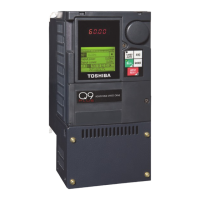10 https://www.toshiba.com/tic/
Installation and Connections
Q9 Plus ASD Install/Op Manual
Mounting the ASD
— The following thermal specifications apply to the
230- and 460-volt ASDs ONLY —
Install the unit securely in a well-ventilated area that
is out of direct sunlight.
The process of converting AC to DC and then back
to AC produces heat. During normal ASD
operation, up to 5% of the input energy to the ASD
may be dissipated as heat. If installing the ASD in a
cabinet, ensure that there is adequate ventilation.
DO NOT operate the ASD with the enclosure door
open.
The ambient operating temperature rating of the Q9
Plus ASD is 14° to 104° F (-10° to 40° C).
When installing multiple ASDs horizontally, Toshiba
recommends at least 5 cm of space between
adjacent units. However, horizontally mounted
ASDs may be installed side-by-side with no space
in between the adjacent units if the top cover is
removed from each ASD.
For 150 HP ASDs and above, a minimum of 50 cm
of space is required above and below adjacent
units and any obstruction. This space is the
recommended minimum space requirement for the
ASD and ensures that adequate ventilation is
provided for each unit. More space will provide a
better environment for cooling (see the section titled
Enclosure Dimensions on pg. 274 for additional
information on mounting space requirements).
Note: Ensure that the ventilation openings are
not obstructed.
Connecting the ASD
Refer to the section titled Installation Precautions
on pg. 3 and the section titled Lead Length
Specifications on pg. 13 before connecting the ASD
and the motor to electrical power.
Power Connections
Contact With 3-Phase Input/Output Terminals
May Cause Electrical Shock Resulting In Injury
Or Loss Of Life.
See Figure 20. on pg. 19 for a system I/O
connectivity schematic.
An inductor (DCL) may be connected across the
PO and PA/+ terminals to provide additional
filtering. When not used, a jumper must be
connected across these terminals (see Figure 20.
on pg. 19).
PA/+ and PB support the DBR function. The DBR
function is NOT used on the Q9 Plus ASD.
PC/- is the negative terminal of the DC bus.
R/L1, S/L2, and T/L3 are the 3-phase input supply
terminals for the ASD.
U/T1, V/T2, and W/T3 are the output terminals of
the ASD that connect to the motor.
The location of the Charge Indicator LED for the
smaller typeform ASD is provided in Figure 2. The
Charge Indicator LED is located on the front door of
the enclosure of the larger ASDs.
CAUTION
DANGER
DANGER
Figure 2. Typical Q9 Plus ASD 3-
phase input/output terminals and
the
Grounding Capacitor
Switch.
Grounding Capacitor Switch
Pull for Small capacitance/push
for Large capacitance.
Note: PO-to-PA/+ shorting
bar removed to show
reference designators.
Charge Indicator
LED
Output
Input

